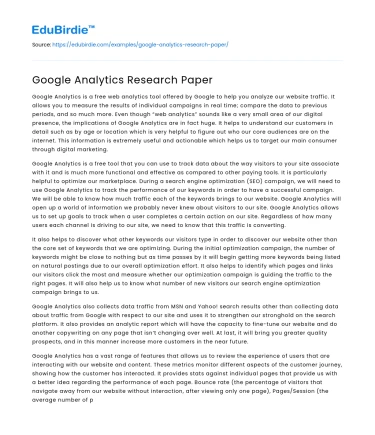Google Analytics is a free web analytics tool offered by Google to help you analyze our website traffic. It allows you to measure the results of individual campaigns in real time; compare the data to previous periods, and so much more. Even though “web analytics” sounds like a very small area of our digital presence, the implications of Google Analytics are in fact huge. It helps to understand our customers in detail such as by age or location which is very helpful to figure out who our core audiences are on the internet. This information is extremely useful and actionable which helps us to target our main consumer through digital marketing.
Google Analytics is a free tool that you can use to track data about the way visitors to your site associate with it and is much more functional and effective as compared to other paying tools. It is particularly helpful to optimize our marketplace. During a search engine optimization (SEO) campaign, we will need to use Google Analytics to track the performance of our keywords in order to have a successful campaign. We will be able to know how much traffic each of the keywords brings to our website. Google Analytics will open up a world of information we probably never knew about visitors to our site. Google Analytics allows us to set up goals to track when a user completes a certain action on our site. Regardless of how many users each channel is driving to our site, we need to know that this traffic is converting.
Save your time!
We can take care of your essay
- Proper editing and formatting
- Free revision, title page, and bibliography
- Flexible prices and money-back guarantee
It also helps to discover what other keywords our visitors type in order to discover our website other than the core set of keywords that we are optimizing. During the initial optimization campaign, the number of keywords might be close to nothing but as time passes by it will begin getting more keywords being listed on natural postings due to our overall optimization effort. It also helps to identify which pages and links our visitors click the most and measure whether our optimization campaign is guiding the traffic to the right pages. It will also help us to know what number of new visitors our search engine optimization campaign brings to us.
Google Analytics also collects data traffic from MSN and Yahoo! search results other than collecting data about traffic from Google with respect to our site and uses it to strengthen our stronghold on the search platform. It also provides an analytic report which will have the capacity to fine-tune our website and do another copywriting on any page that isn’t changing over well. At last, it will bring you greater quality prospects, and in this manner increase more customers in the near future.
Google Analytics has a vast range of features that allows us to review the experience of users that are interacting with our website and content. These metrics monitor different aspects of the customer journey, showing how the customer has interacted. It provides stats against individual pages that provide us with a better idea regarding the performance of each page. Bounce rate (the percentage of visitors that navigate away from our website without interaction, after viewing only one page), Pages/Session (the average number of pages each visitor has viewed) and Average Session Duration (the average amount of time spent on the website by each visitor) are some important measures of Google Analytics.
Google Analytics allows us to monitor which devices our users are using which gives us some indication as to how well our mobile site is working in comparison to the desktop version. If we are receiving a similar amount of visitors from each platform but fewer conversions from one, there is some issue with that version of that site.
If we summarize the importance of Google Analytics, it allows you to track many important metrics, covering all aspects. We can monitor the effectiveness of our online marketing strategies, onsite content, user experience, and device functionality. All these statistics show us what is working well, and more importantly, what isn’t. Once you identify these issues that our site may have, we can create a solution. Google Analytics allows us the critical information needed to improve our website.






 Stuck on your essay?
Stuck on your essay?

